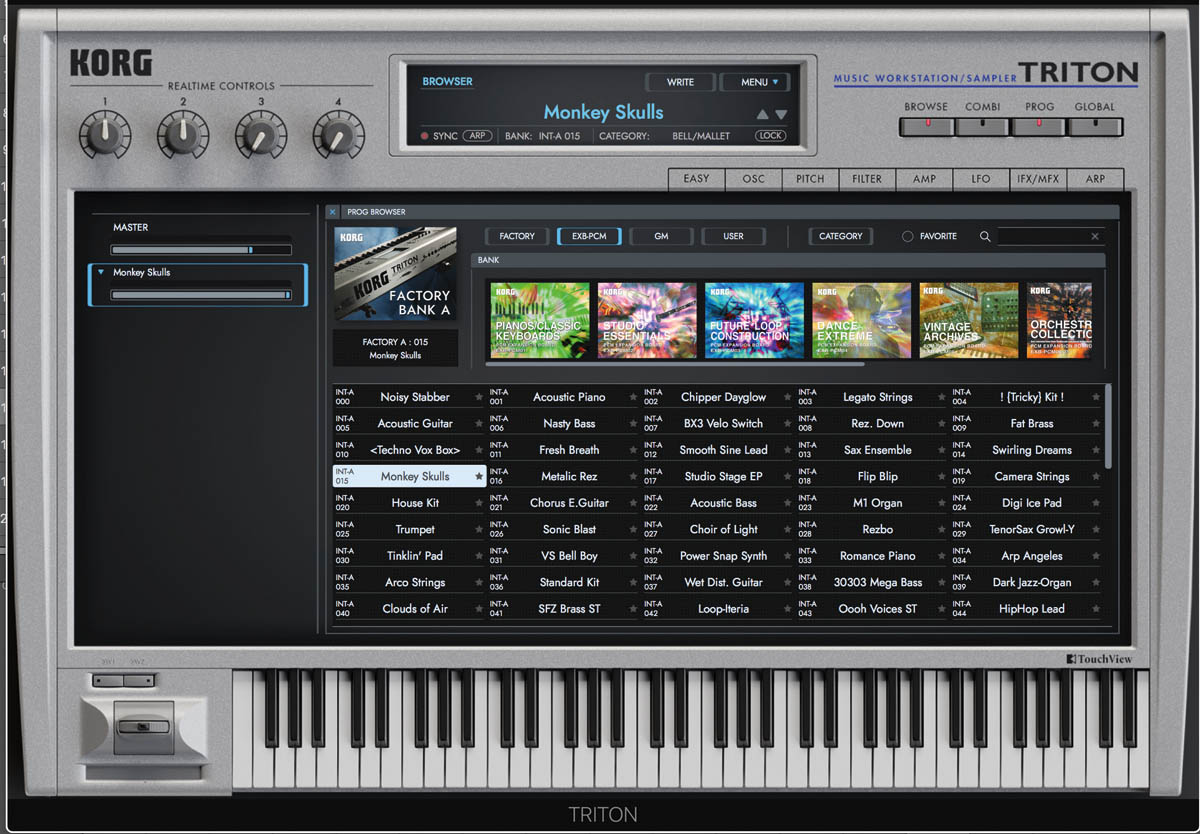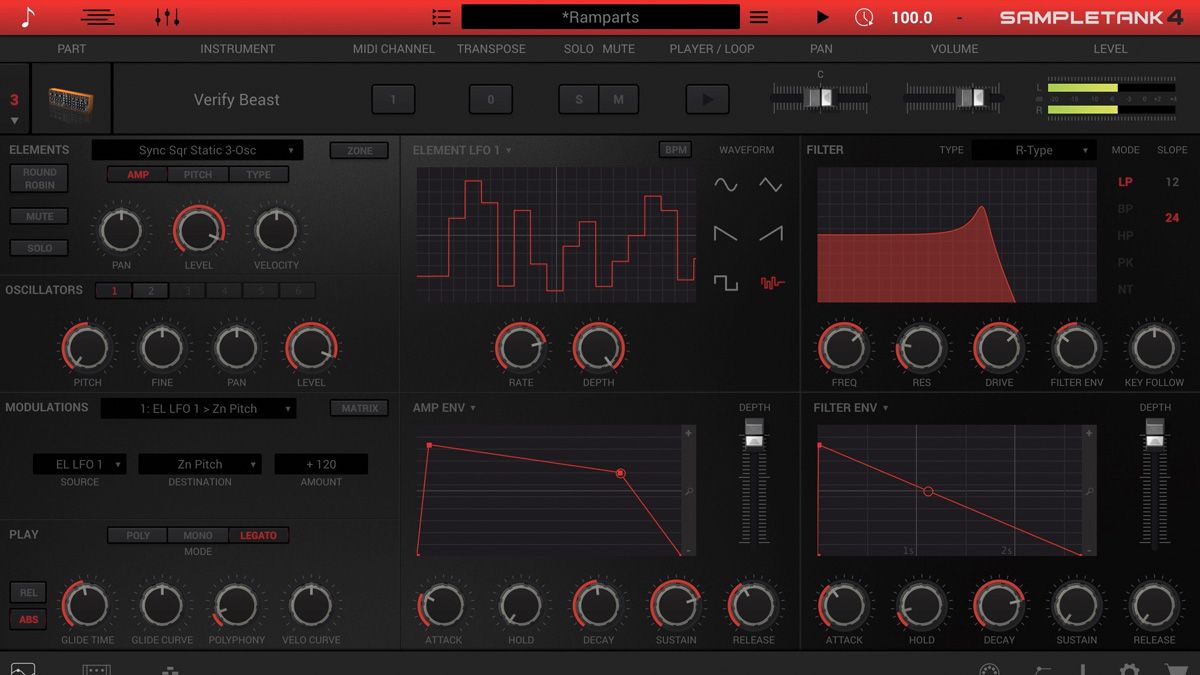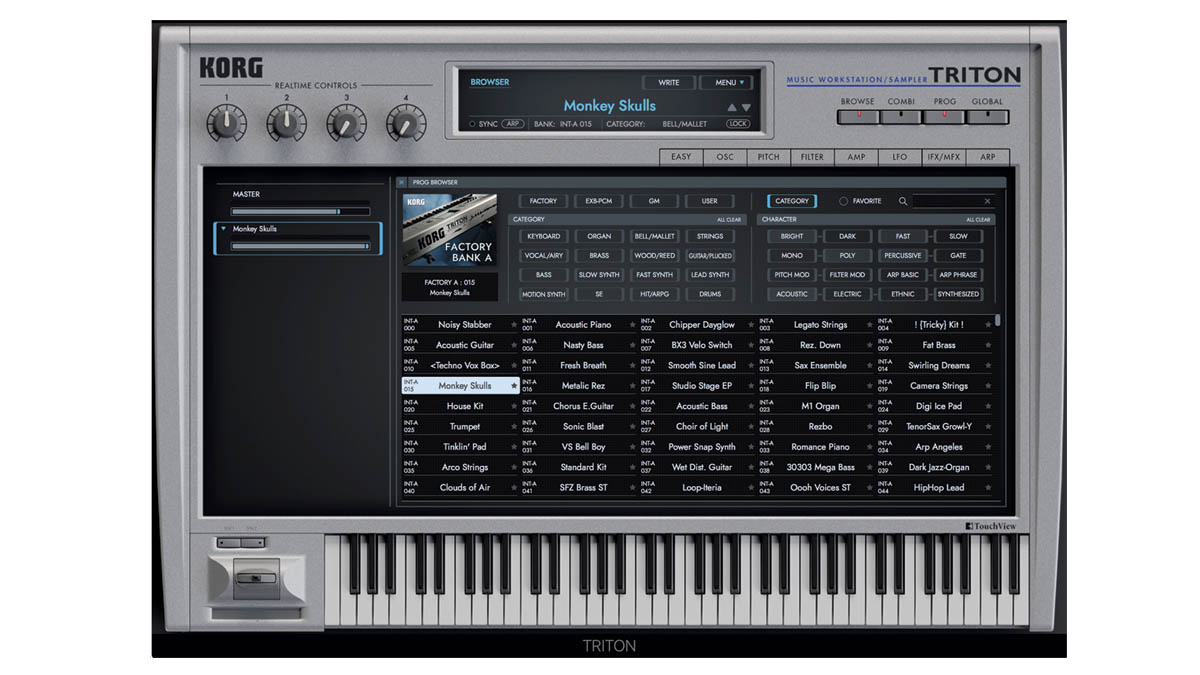MusicRadar Verdict
It’s a Triton, fully recreated in software and it will cover as many bases (and basses) as the original. It’s a great recreation, simple!
Pros
- +
Huge and varied sound.
- +
Great browser to select your sounds.
- +
Proper rose-tinted sonic experience!
- +
Usable for a wide range of genres.
- +
Eight custom MIDI controller layouts.
Cons
- -
Expensive as single purchase.
- -
Some not-so-cool sounds now.
MusicRadar's got your back
What is it?
There is a whiff of a '90s revival in the air. To some of us of a certain age, of course, that decade might not seem that far gone, but Calvin Harris’ recent track, Hypnagogic (I Can’t Wait), under his Love Generator moniker reminded us of everything we loved about that decade (and indeed, much of what we didn’t).
And it does seem to be the latest in a line of throwbacks to the '90s, that could include this latest softsynth release, the Korg Collection: Korg Triton. The original hardware Triton came out in the latter part of the 90s and variants of it were released well into the following decade.
However its sound and format was largely honed from earlier Korg keyboards from the 90s such as the Trinity range, and you could even argue that it took its all-singing-all-dancing workstation ethos from the mighty M1, a keyboard that defined a lot of genres during the '90s and beyond.
90s synths, so laden down with menus and sub menus can now be a joy to use on a computer
It’s a big concept synth then, one of those ROMpler-based packages where you get a tonne of sounds covering ‘real’ instruments plus pads, basses, leads and other synth sounds for more electronic-based music production.
This workstation concept was designed to cover pretty much every type of music production and you paid big bucks for them back in 1999. And $249 is not exactly small change for a softsynth these days, although there are other, more reasonable buying options.
You can also get Triton as part of the Korg Collection bundle where $399 gets you eight classic software recreations that include the ARP Odyssey, MS-20, PolySix and M1 (all of which are amazing versions of the original hardware, so we’d thoroughly recommend it).
You can also upgrade your existing Korg Collection to include Triton for $149. Best of all, you can actually try Triton out by registering for the Korg Software Pass, with which you then download Triton (400MB) and install it. Here you get a 20-minute demo, so it’s worth doing this if you’re at all curious (you can also trial the other titles in the Collection here too).

Performance and verdict
Triton was developed as an exacting replica of the hardware, including the HI (Hyper Integrated) synthesis system engine at its core, its 8-part multitimbral architecture (where you can play eight different sound combinations, or just huge performances), effects and 4,000 sounds that cover all of the original eight expansions that include Vintage, Orchestral and Trance collections.
Understandably, a lot of new tech comes to the party as well, including a software browser to help get you through all of those sounds, and next to the nostalgic feeling of getting access to these Korg classics, is probably the biggest highlight.
It simply lays out all of the sounds into categories – divided into a dozen Instrument or Character sections – or by the Expansions, with the original artwork shown to click through. Homing in on the sound you want here – or simply getting lost on a sonic time-travel trip – really is as easy as child’s play. As to the results, well, we’ve tried to sum it all up to the right, but you won’t be disappointed with the sheer depth and width on offer. But there’s more.
Homing in on the sound you want here – or getting lost on a sonic time-travel trip – really is as easy as child’s play
You can get an overview of each sound’s architecture by hitting the Easy button, which gives you a succinct picture of the Osc, Pitch, Amp, Filter, Envelope, Effects and Arpeggiator settings, or delve deeper into each by pressing the relevant button to the top right of the UI.
It’s a simple and elegant system that reminds you, yet again, why using classic synths from the 90s, so laden down with menus and sub menus, can be such a delight to now use on a computer screen. If anything using these classics in your DAW, makes programming them far easier than the original hardware.

• IK Multimedia SampleTank 4 Max
A huge amount of real and synthetic sounds in the ultimate software ROMpler.
• Roland Cloud
Roland synths and workstations on subscription in software, offering both analogue and digital sounds.
As we’ve already said, Triton is not a cheap purchase, so you might want to try that 20-minute demo out and, of course, make sure that your existing instruments don’t already cover a lot of its bases. Certainly a decent DAW’s suite of plugin instruments will cover a lot of what Triton does, albeit not with quite as much pizzazz, nor within the beautiful soft shell that Korg have created here.
And on that, Triton does seem to have achieved what a number of recent releases have attempted, with the confidence that only a company with this kind of heritage can muster. You can tell the original developers were supervising Triton, as it easily delivers all of that history, over 4,000 sounds and all of that original architecture behind a great interface.
Where other products like this can feel bloated, Triton most certainly doesn’t. In fact, by the end of this review, we were starting to feel that there is simply so much on offer that the single-purchase price tag is not so over the top after all – SampleTank can cost more, and Roland’s Cloud subscription does mount up.
So if you need a one-plugin-fits-all solution for a huge variety of genres, with some classic dance piano sounds to die for, and feel like taking a trip back a couple of decades to that crazy (well, depending on what you made of it) decade, then Triton has all you need… and much, much more.
MusicRadar verdict: It’s a Triton, fully recreated in software and it will cover as many bases (and basses) as the original. It’s a great recreation, simple.
Hands-on demos
Ave Mcree
Korg
Emlyn in the Mix
Specifications
- Type: Music workstation / VST plug-in
- Key features: Korg Triton HI synthesis in software form, including real-time controls, main preset list, pitch/mod controls, keyboard, etc.
- System requirements: Mac OS X 10.12 Sierra or higher; Windows 10 64bit or higher; 6 GB RAM (8 GB or more recommended) Storage: 8 GB free disk space (SSD recommended)
- Compatibility: Ableton Live 10, Cubase Pro 10, Digital Performer 10, Studio One 4.5, FL Studio 20, Reason 11
- Contact: Korg
Computer Music magazine is the world’s best selling publication dedicated solely to making great music with your Mac or PC computer. Each issue it brings its lucky readers the best in cutting-edge tutorials, need-to-know, expert software reviews and even all the tools you actually need to make great music today, courtesy of our legendary CM Plugin Suite.
“I used everything I knew about music”: How Green Day exceeded expectations with their most ambitious song
YouTube just added AI tools that makes musicians, library music and video editors redundant
“Every one of them said yes without hesitation": Hank Marvin and Roger Taylor have just remade a '60s classic for charity











